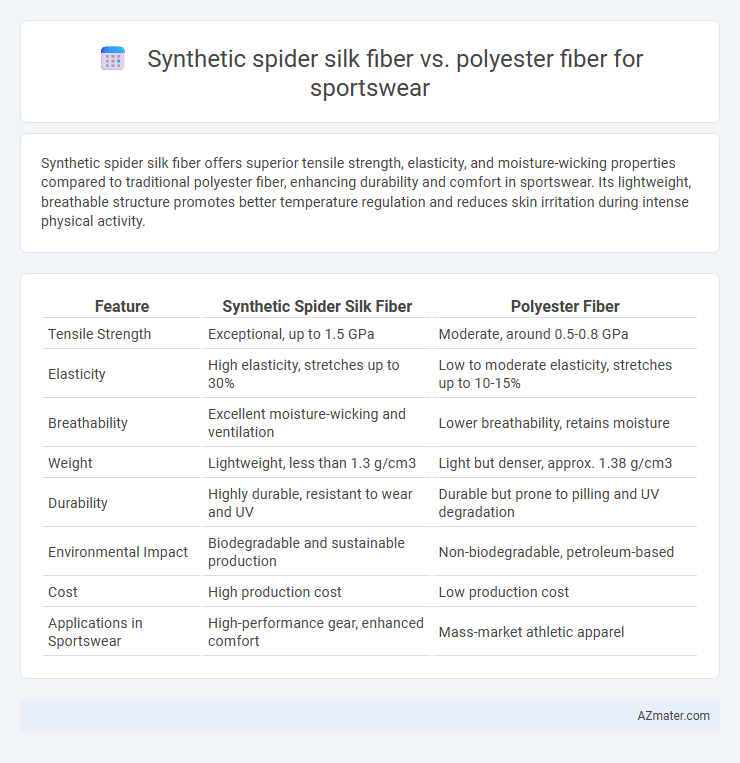Synthetic spider silk fiber offers superior tensile strength, elasticity, and moisture-wicking properties compared to traditional polyester fiber, enhancing durability and comfort in sportswear. Its lightweight, breathable structure promotes better temperature regulation and reduces skin irritation during intense physical activity.
Table of Comparison
| Feature | Synthetic Spider Silk Fiber | Polyester Fiber |
|---|---|---|
| Tensile Strength | Exceptional, up to 1.5 GPa | Moderate, around 0.5-0.8 GPa |
| Elasticity | High elasticity, stretches up to 30% | Low to moderate elasticity, stretches up to 10-15% |
| Breathability | Excellent moisture-wicking and ventilation | Lower breathability, retains moisture |
| Weight | Lightweight, less than 1.3 g/cm3 | Light but denser, approx. 1.38 g/cm3 |
| Durability | Highly durable, resistant to wear and UV | Durable but prone to pilling and UV degradation |
| Environmental Impact | Biodegradable and sustainable production | Non-biodegradable, petroleum-based |
| Cost | High production cost | Low production cost |
| Applications in Sportswear | High-performance gear, enhanced comfort | Mass-market athletic apparel |
Introduction to Synthetic Spider Silk and Polyester Fibers
Synthetic spider silk fiber, engineered to mimic the extraordinary strength and elasticity of natural spider silk, offers exceptional durability and moisture-wicking properties ideal for high-performance sportswear fabrics. Polyester fiber, widely used in sportswear due to its cost-effectiveness, wrinkle resistance, and quick-drying capabilities, provides reliable comfort and breathability but lacks the natural resilience and stretch of synthetic spider silk. Advances in biotechnology enable synthetic spider silk to outperform polyester in tensile strength and elasticity, making it a revolutionary choice for durable, flexible athletic apparel.
Material Composition and Structural Differences
Synthetic spider silk fiber consists of protein-based polymers replicating the natural silk's beta-sheet crystalline structures, offering exceptional tensile strength and elasticity. Polyester fiber is composed of polyethylene terephthalate (PET), a synthetic polymer characterized by semi-crystalline regions that provide durability but less flexibility compared to spider silk. The hierarchical molecular arrangement in synthetic spider silk enables superior breathability and moisture-wicking properties, whereas polyester's dense molecular chains result in lower moisture permeability and higher thermal retention in sportswear applications.
Mechanical Strength and Durability
Synthetic spider silk fiber exhibits superior mechanical strength compared to polyester fiber, with tensile strength reaching up to 1.75 GPa, surpassing polyester's typical range of 0.5-0.8 GPa. Its exceptional elasticity and toughness enhance durability, allowing sportswear to withstand repeated stress and deformation without significant wear. Polyester, while cost-effective and resistant to abrasion, generally lacks the combined high strength and flexibility of synthetic spider silk, making the latter more suitable for high-performance athletic apparel requiring long-lasting durability.
Moisture Wicking and Breathability
Synthetic spider silk fiber exhibits superior moisture-wicking properties compared to polyester fiber, efficiently drawing sweat away from the skin to maintain dryness during intense physical activity. Its unique protein-based structure allows for enhanced breathability, facilitating better air circulation and temperature regulation in sportswear. In contrast, polyester fibers often trap heat and moisture, leading to discomfort and reduced performance in high-sweat conditions.
Comfort and Skin Sensitivity
Synthetic spider silk fiber offers superior moisture-wicking and breathability compared to polyester fiber, enhancing comfort during intense sports activities. Its natural protein-based structure reduces irritation and allergic reactions, making it ideal for sensitive skin. Polyester fiber tends to trap heat and moisture, often causing discomfort and skin irritation during prolonged wear.
Environmental Impact and Sustainability
Synthetic spider silk fiber offers significant environmental advantages over polyester fiber in sportswear due to its biodegradability and lower carbon footprint during production. Unlike polyester, which is derived from petroleum and contributes to microplastic pollution and non-biodegradable waste, synthetic spider silk is biologically produced and decomposes naturally, reducing landfill burden. The sustainable manufacturing process of synthetic spider silk promotes resource efficiency, making it a preferable eco-friendly alternative in high-performance athletic apparel.
Cost and Commercial Availability
Synthetic spider silk fiber offers exceptional strength and elasticity for sportswear but remains significantly more expensive than polyester fiber, limiting its widespread commercial use. Polyester fiber dominates the market due to its low cost, high durability, and extensive availability in diverse textile forms. Despite ongoing advancements, synthetic spider silk's commercial production struggles to compete with polyester's scalability and affordability in sportswear manufacturing.
Performance in Various Sports Conditions
Synthetic spider silk fiber offers exceptional tensile strength and elasticity, outperforming polyester fiber in durability and flexibility under dynamic sports conditions. Its moisture-wicking and temperature-regulating properties enhance comfort during high-intensity activities, making it ideal for endurance sports and outdoor performance. Polyester fiber, while durable and quick-drying, lacks the adaptive stretch and breathability of synthetic spider silk, which can limit performance in fluctuating weather and strenuous movements.
Innovations and Future Prospects
Synthetic spider silk fiber offers remarkable tensile strength, elasticity, and biocompatibility, making it an innovative material for high-performance sportswear that enhances comfort and durability compared to traditional polyester fiber. Advanced bioengineering techniques enable scalable production of synthetic spider silk, promising sustainable and lightweight fabrics with superior moisture-wicking and temperature regulation properties. Future prospects include integrating synthetic spider silk with smart textile technologies to create adaptive sportswear that responds dynamically to athletic movements and environmental conditions.
Conclusion: Choosing the Right Fiber for Sportswear
Synthetic spider silk fiber offers superior tensile strength, elasticity, and moisture-wicking properties compared to polyester fiber, making it ideal for high-performance sportswear. Its lightweight and biodegradable nature provides enhanced comfort and environmental sustainability. Polyester fiber remains a cost-effective option with durability and easy-care benefits, but synthetic spider silk stands out for advanced athletic applications requiring optimal performance and eco-friendliness.

Infographic: Synthetic spider silk fiber vs Polyester fiber for Sportswear
 azmater.com
azmater.com